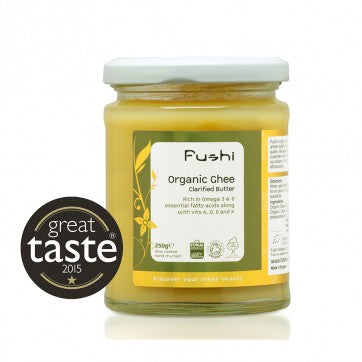
From organic grass fed cows.
Organic ghee or clarified butter has been recognised and highly valued by Ayurveda, the ancient medical science of India.
Placed at the top of the oily foods list, ghee is considered to be an essential part of a balanced diet. According to tradition it not only benefits the internal health of the body but also softens, strengthens and nourishes the skin.
Ghee has immense healing benefits as it contains a balance of easy to digest fatty acids essential for healthy nerves and cells. Known for it anti-inflammatory properties, it is also rich with antioxidants and acts as an aid in the absorption of vitamins and minerals from other foods.
Ghee has a high smoke point and therefore does not produce damaging free radicals.
Fushi authentic organic ghee is traditionally churned and made with great care at a local farm in the Cotswold Hills in the South West of England.
It is made with artisan butter and cream produced fresh daily from free range grass fed cows for most of the year between March and November. While in harsher weather between December to February the cows are fed organic feed.
Organically certified by the Soil Association and produced only in small batches from quality English butter, Fushi organic ghee is cooked slowly for 6 8 hours to rid it of any impurities. This results in a pure ghee with a lovely fragrance and colour.
There are no added flavourings, preservative or colourings.
Details Click to see more
What is ghee?
Ghee is butter that has been slowly cooked for hours to remove any impurities, water, lactose and milk solids. People in the West may be less familiar with ghee and its wonderful nutritional profile as it originated in South Asia. Ghee has been an important staple in Indian cuisine for centuries and in Asian cultures it is renowned for its healing qualities.
What are the benefits of using ghee?
Ghee contains a combination of both saturated and unsaturated fats and includes short-chained fats making it easy to digest. It is incredibly rich in butyric acid, a short-chain fatty acid that is beneficial in helping to maintain the health of the cells that line the gastrointestinal tract. Ghee is also rich in antioxidants, contains conjugated linoleic acid and is also a great source of fat soluble vitamins A, D, E and K. Additionally, it has an extremely high smoke point (around 480 degree F or 248 C), making it an excellent choice for frying with as it doesnt burn easily. Ghee is not only beneficial for the body but also for the mind. Ayurveda regards ghee as key part of a balanced diet. It is considered one of the principle foods for protecting and nourishing the health of the skin, as well as maintaining good digestion and mental clarity.
How is Fushi ghee made?
Fushi ghee is made from small batches of traditionally churned quality English butter and cooked slowly for 6 8 hours to rid it of any impurities. This results in a pure ghee with a lovely fragrance and colour. There are no added flavourings, preservative or colourings.
Is it made from grass-fed cows milk?
The cows are fed grass between March and November, while in harsher weather between December to February the cows are fed organic feed, consisting of hay. The cows are never fed grains.
What are the cows fed on in winter months?
In harsher weather between December to February when fresh grass is not available, the cows are fed organic feed, consisting of hay. The cows are never fed grains.
What is artisan butter?
Artisan butter is made by hand in a traditional, non-mechanised way of using high-quality milk.
Is Fushi ghee pasteurised and/or homogenised?
Fushi ghee is made from butter which has been produced by using pasteurized cream. Ghee is not homogenized.
How to cook with ghee?
Ghee is primarily used as a cooking fat. It has an extremely high smoke point (around 480 degree F or 248 C), making it an excellent choice for frying with as it doesnt burn easily. Furthermore, ghee is incredibly versatile. It can be regularly used for the following: roasting spuds and other root vegetables like parsnips and beets whipping up the odd curry a butter substitute when baking cakes drizzling over popcorn mixing with garlic and parsley to make gluten free garlic bread sauting vegetables making scrambled eggs spreading on toast
Does ghee need to be refrigerated?
Refrigeration of ghee is optional. Ghee is composed almost entirely of fat, with water and milk solids removed, therefore it doesnt require any refrigeration. It can be stored at room temperature in a cool, dark place away from direct heat and light. However as in warmer temperatures ghee can melt and become liquid, you can refrigerate it to keep it in a solid state.
What is the shelf life of ghee?
Once opened it usually has a shelf life of around 12 months.
Why does ghee appear separated?
It is only some melted ghee separating on top from warm temperature. This does not affect the quality. You can either just stir it or place it in the fridge to solidify again.
What consistency is ghee supposed to be?
It is perfectly normal for ghee to be liquid, solid or a combination of both. It depends on the storage temperature. Ghee is similar to coconut oil in the sense that it melts when it is above 20 degrees C. This is totally normal and does not compromise the quality of the ghee. Ghee will return to a semi-solid consistency when it returns to below 20 degrees C.
Why does Fushis ghee have a grainy texture?
It is completely natural for ghee to have a grainy texture. Ghee is melted over a low temperature before hand pouring it into jars, which then are placed in the fridge to solidify. This sudden change of temperatures creates a grainy texture.
Is ghee a dairy product?
Ghee is classed as a dairy product as it is made from milk. However most people who do not tolerate dairy, find that they can safely consume ghee.
Does it contain casein and lactose?
Most of the lactose and casein is removed during the manufacturing process, however it is possible that tiny amounts may still remain. Therefore individuals who are incredibly sensitive may react when eating ghee and should probably avoid it.
How much ghee can I eat?
It is very individual. You can substitute ghee for most other fats you use in the kitchen. For individual fat intake requirements we suggest to consult a nutritionist.
Is Fushis ghee cultured or fermented in any way?
Our ghee is not cultured or fermented.
Can ghee be used externally?
Ghee is great as hair treatment: massage into the scalp and throughout the length of hair, leave overnight and wash out in the morning using a natural shampoo. It can also be used for cuts, burns and dry skin.

